Historical Context and Leaders

The conflict between Israel and Hamas is a complex and multifaceted issue with a long and troubled history. Understanding the historical context is crucial to grasping the complexities of the conflict and the motivations of the key players involved.
Historical Relationship
The relationship between Israel and Hamas is rooted in the ongoing Israeli-Palestinian conflict, a struggle over land and resources that has spanned decades. Hamas, a Palestinian Islamist organization, was founded in 1987 during the First Intifada, a Palestinian uprising against Israeli occupation.
- Hamas emerged as a response to the perceived failure of the Palestine Liberation Organization (PLO) to achieve Palestinian statehood.
- Hamas’s ideology is based on a fundamentalist interpretation of Islam, and it seeks to establish an Islamic state in all of historical Palestine.
- Hamas has been involved in armed conflict with Israel since its inception, launching numerous attacks and engaging in armed resistance against Israeli forces.
Key Events and Figures
The conflict between Israel and Hamas has been marked by a series of key events and the emergence of prominent figures on both sides.
- 1987: The First Intifada begins, marking the rise of Hamas as a prominent Palestinian resistance group.
- 1993: The Oslo Accords are signed, creating a framework for Palestinian autonomy in parts of the West Bank and Gaza Strip. However, Hamas rejects the accords and continues its armed struggle.
- 2000: The Second Intifada begins, characterized by intensified violence and a breakdown in the peace process.
- 2006: Hamas wins the Palestinian legislative elections, marking a significant shift in the political landscape of the Palestinian territories.
- 2007: Hamas takes control of the Gaza Strip after a violent conflict with Fatah, the rival Palestinian political faction.
- 2008-2009: Israel launches Operation Cast Lead, a military offensive against Hamas in the Gaza Strip.
- 2012: Israel launches Operation Pillar of Defense, another military offensive against Hamas in Gaza.
- 2014: Israel launches Operation Protective Edge, a major military operation against Hamas in Gaza.
- 2021: The 11-day conflict between Israel and Hamas in Gaza, resulting in significant destruction and civilian casualties.
Evolution of Hamas Leadership
Hamas’s leadership has evolved over time, reflecting shifts in the organization’s priorities and strategies.
- Sheikh Ahmed Yassin (1987-2004): Yassin was the founder and spiritual leader of Hamas, known for his unwavering commitment to the establishment of an Islamic state in Palestine. He was assassinated by Israel in 2004.
- Khaled Mashal (2004-present): Mashal, a senior Hamas leader, took over as the organization’s political leader after Yassin’s assassination. He is known for his strategic approach and his efforts to build international support for Hamas.
- Ismail Haniyeh (2006-present): Haniyeh, a prominent Hamas leader, has served as the Prime Minister of the Hamas government in Gaza since 2006. He is known for his focus on social welfare and his efforts to rebuild Gaza after repeated Israeli military operations.
Leadership Styles, Israel hamas leader
Hamas leaders have exhibited distinct leadership styles, reflecting their backgrounds and ideologies.
- Sheikh Ahmed Yassin: Yassin’s leadership style was characterized by charisma, religious authority, and unwavering commitment to the cause of Palestinian liberation. He inspired followers through his speeches and writings, emphasizing the importance of armed resistance against Israel.
- Khaled Mashal: Mashal’s leadership style is more pragmatic and strategic. He has focused on building international alliances and seeking diplomatic solutions to the conflict. He is also known for his ability to navigate complex political situations.
- Ismail Haniyeh: Haniyeh’s leadership style is characterized by his focus on social welfare and his efforts to improve the lives of Palestinians in Gaza. He is known for his ability to connect with ordinary people and his commitment to providing essential services.
Hamas’ Political and Military Structure

Hamas, a Palestinian Islamist organization, operates with a complex structure encompassing both political and military aspects. Its political wing engages in Palestinian governance and diplomacy, while its military wing, the Izz ad-Din al-Qassam Brigades, conducts armed operations against Israel. This intricate structure reflects the organization’s dual role as a political movement and an armed resistance group.
Hamas’ Political Structure and Relationship with the Palestinian Authority
Hamas’ political structure is hierarchical, with a leadership council that sets overall policy and a Shura Council that acts as an advisory body. The political wing participates in Palestinian elections and holds seats in the Palestinian Legislative Council (PLC). However, Hamas’ relationship with the Palestinian Authority (PA) has been marked by tension and conflict. Since 2007, Hamas has controlled the Gaza Strip, while the PA governs the West Bank. This division has resulted in a power struggle between the two entities, with both claiming legitimacy over the Palestinian people.
Organization of the Izz ad-Din al-Qassam Brigades
The Izz ad-Din al-Qassam Brigades, Hamas’ military wing, is organized into several units responsible for different aspects of military operations. These units include:
- Special Forces: Highly trained units responsible for conducting special operations, including assassinations and raids.
- Rocket and Missile Units: Responsible for developing and launching rockets and missiles against Israeli targets.
- Infantry Units: Ground troops responsible for engaging in direct combat with Israeli forces.
- Intelligence and Security Units: Gather intelligence on Israeli military activities and provide security within the Gaza Strip.
The Brigades are known for their sophisticated rocket technology and their ability to wage prolonged conflicts with Israel.
Role of Hamas’ Political Leaders in Decision-Making Regarding Military Operations
Hamas’ political leaders play a crucial role in decision-making regarding military operations. The leadership council, led by the Hamas political bureau, makes strategic decisions on the use of force. While the military wing operates autonomously, it is ultimately accountable to the political leadership. This structure ensures that military actions are aligned with Hamas’ overall political objectives.
Key Departments and Responsibilities within Hamas’ Structure
| Department | Responsibilities |
|---|---|
| Political Bureau | Sets overall political strategy, oversees foreign relations, and coordinates with other Palestinian factions. |
| Shura Council | Provides advice and guidance to the political leadership, particularly on religious and legal matters. |
| Izz ad-Din al-Qassam Brigades | Conducts military operations against Israel, including rocket attacks, ambushes, and infiltration raids. |
| Ministry of Interior | Responsible for internal security, law enforcement, and administration within the Gaza Strip. |
| Ministry of Health | Provides healthcare services to the population of the Gaza Strip. |
| Ministry of Education | Manages the education system within the Gaza Strip. |
Hamas’ Goals and Strategies: Israel Hamas Leader

Hamas, a Palestinian Islamic organization, has a complex set of goals and employs various strategies to achieve them. Its objectives range from the establishment of an independent Palestinian state to the destruction of Israel, and its tactics encompass political negotiations, military operations, and social programs.
Hamas’ Stated Goals
Hamas’ goals are Artikeld in its charter, which calls for the liberation of Palestine from Israeli control and the establishment of an Islamic state in the territory. The charter also explicitly rejects any peace agreements with Israel and advocates for the use of armed struggle to achieve its objectives.
Hamas’ Strategies
Hamas employs a multi-pronged strategy to achieve its goals, combining political, military, and social tactics:
Political Negotiations
While Hamas has historically opposed peace negotiations with Israel, it has participated in some political processes. In 2006, Hamas won a majority in the Palestinian legislative elections, leading to a period of political power-sharing with Fatah. However, this arrangement proved unstable and ultimately collapsed, leading to a split between the two groups.
Military Operations
Hamas maintains a well-equipped and organized military wing, known as the Izz ad-Din al-Qassam Brigades, which has been responsible for numerous attacks against Israel. These attacks include rocket fire, tunnel incursions, and suicide bombings. Hamas’ military operations have been a significant factor in the ongoing Israeli-Palestinian conflict, often leading to escalations of violence and civilian casualties.
Social Programs
Hamas has also invested heavily in social programs, providing services such as healthcare, education, and welfare to the Palestinian population. These programs have helped to solidify Hamas’ popularity among Palestinians, particularly in the Gaza Strip, where it has a strong presence.
Impact of Hamas’ Actions
Hamas’ actions have had a profound impact on the Israeli-Palestinian conflict. Its military operations have led to significant loss of life and property on both sides, while its political stance has hindered peace efforts. Additionally, Hamas’ control of the Gaza Strip has resulted in a humanitarian crisis, with the territory facing severe economic hardship and a lack of basic necessities.
Hamas’ Key Achievements and Setbacks
Hamas has experienced both successes and setbacks in its pursuit of its goals:
Achievements
- Victory in the 2006 Palestinian legislative elections, giving Hamas control of the Palestinian government.
- Establishment of a strong social infrastructure in the Gaza Strip, providing essential services to the population.
- Successfully resisting Israeli military incursions into Gaza, demonstrating its military capability.
Setbacks
- The 2007 split with Fatah, leading to a division within the Palestinian movement.
- The imposition of a blockade on the Gaza Strip by Israel and Egypt, resulting in economic hardship and humanitarian crisis.
- The failure to achieve its stated goal of liberating all of Palestine, with Israel remaining in control of significant portions of the territory.
Israel hamas leader – The conflict between Israel and Hamas leaders is a complex and sensitive issue. It’s important to remember that while we’re focused on global events, there are also everyday concerns like protecting our outdoor furniture. A good quality threshold patio club chair cover can help keep your chairs looking their best, just like we hope for a peaceful resolution to the Israel-Hamas conflict.
The conflict between Israel and Hamas is a complex issue with a long history. It’s often intertwined with the Iranian-Israeli relationship, as Iran is a key supporter of Hamas. The dynamics between these three players continue to shape the landscape of the Middle East, with each side seeking to secure their own interests.
